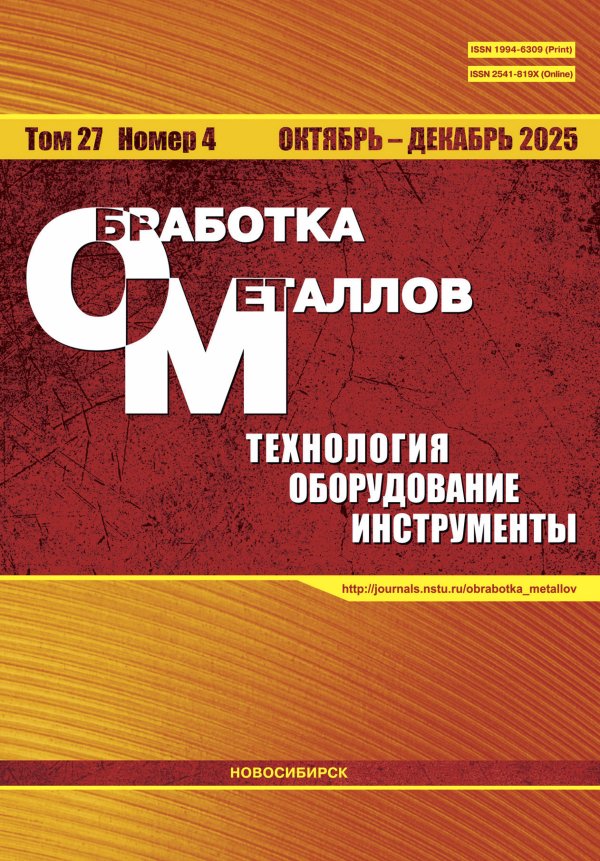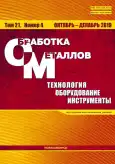Зависимость изнашивания инструмента и параметров качества формируемой резанием поверхности от динамических характеристик
- Авторы: Заковоротный В.Л.1, Гвинджилия В.Е.1
-
Учреждения:
- Выпуск: Том 21, № 4 (2019)
- Страницы: 31-46
- Раздел: ОБОРУДОВАНИЕ. ИНСТРУМЕНТЫ
- URL: https://bakhtiniada.ru/1994-6309/article/view/302049
- DOI: https://doi.org/10.17212/1994-6309-2019-21.4-31-46
- ID: 302049
Цитировать
Полный текст
Аннотация
Об авторах
В. Л. Заковоротный
Email: vzakovorotny@dstu.edu.ru
доктор техн. наук, Профессор, Донской государственный технический университет, пл. Гагарина, 1, г. Ростов-на-Дону, 344000, Россия, vzakovorotny@dstu.edu.ru
В. Е. Гвинджилия
Email: sinedden@yandex.ru
аспирант, Донской государственный технический университет, пл. Гагарина, 1, г. Ростов-на-Дону, 344000, Россия, sinedden@yandex.ru
Список литературы
- Рыжкин А.А. Синергетика изнашивания инструментальных материалов при лезвийной обработке / Донской гос. техн. ун-т. – Ростов н/Д.: ДГТУ, 2019. – 289 с. – ISBN 978-5-7890-1669-5.
- Безъязычный В.Ф., Фоменко В.В., Непомилуев В.В. Исследование влияния технологических условий обработки точением режущим инструментом с износостойкими покрытиями на параметры качества поверхностного слоя деталей машин // Упрочняющие технологии и покрытия. – 2017. – Т. 19, № 3. – С. 108–113.
- Васин С.А. Резание материалов: термомеханический подход к системе взаимосвязей при резании. – М.: Изд-во МГТУ им. Н.Э. Баумана, 2001. – 447 с. – ISBN 5-7038-1823-0.
- Макаров А.Д. Оптимизация процессов резания. – М.: Машиностроение, 1976. – 278 с.
- Зорев Н.Н. Влияние природы износа режущего инструмента на зависимость его стойкости от скорости резания // Вестник машиностроения. – 1965. – № 2. – С. 68–76.
- Козочкин М.П., Алленов Д.Г. Исследование влияния износа режущей кромки инструмента на деформации поверхностного слоя детали // Вестник МГТУ «Станкин». – 2015. – № 4 (35). – С. 22–29.
- Постнов В.В., Шафиков А.А. Разработка эволюционной модели изнашивания режущего инструмента для управления процессом обработки // Вестник Уфимского государственного авиационного технического университета. – 2008. – Т. 11, № 2. – С. 139–145.
- Суслов А.Г. Качество поверхностного слоя деталей машин. – М.: Машиностроение, 2000. – 320 с.
- Hahn R.S. On the theory of regenerative chatter in precision grinding operation // Transactions of American Society of Mechanical Engineers. – 1954. – Vol. 76. – P. 593–597.
- Кудинов В.А. Динамика станков. – М.: Машиностроение, 1967. – 359 c.
- Tlusty I., Ismail F. Basic non-linearity in Machining Chatter // CIRP Annals – Manufacturing Technology. – 1981. – Vol. 30. – P. 299–304. – doi: 10.1016/S0007-8506(07)60946-9.
- Жарков И.Г. Вибрации при обработке лезвийным инструментом. – Л.: Машиностроение, 1987. – 184 с.
- Chaotic vibrations in regenerative cutting process / J. Warminski, G. Litak, J. Lipski, M. Wiercigroch, M.P. Cartmell // IUTAM/IFToMM Symposium on Synthesis of Nonlinear Dynamical Systems. – Dordrecht; Boston: Kluwer Academic Publishers, 2000. – P. 275–284.
- Городецкий Ю.И. Теория нелинейных колебаний и динамика станков // Вестник Нижегородского университета им. Н.И. Лобачевского. Математическое моделирование и оптимальное управление. – 2001. – № 2. – С. 69–88.
- Balachandran B. Nonlinear dynamics of milling process // Philosophical Transactions of the Royal Society A: Mathematical Physical and Engineering Sciences. – 2001. – Vol. 359 (1781). – P. 793–819.
- Stepan G., Szalai R. Insperger T. Nonlinear dynamics of high-speed milling subjected to regenerative e?ect // Nonlinear Dynamics of Production Systems. – Weinheim: Wiley-VCH, 2004. – P. 111–127.
- Wiercigroch M., Budak E. Sources of nonlinearities, chatter generation and suppression in metal cutting // Philosophical Transactions of the Royal Society A: Mathematical, Physical and Engineering Sciences. – 2001. – Vol. 359 (1781). – P. 663–693. – doi: 10.1098/rsta.2000.0750.
- Wiercigroch M., Krivtsov A.M. Frictional chatter in orthogonal metal cutting // Philosophical Transactions of the Royal Society A: Mathematical, Physical and Engineering Sciences. – 2001. – Vol. 359 (1781). – P. 713–738. – doi: 10.1098/rsta.2000.0752.
- Litak G. Chaotic vibrations in a regenerative cutting process // Chaos, Solitons and Fractals. – 2002. – Vol. 13. – P. 1531–1535. – doi: 10.1016/S0960-0779(01)00176-X.
- Nonlinear dynamics of a machining system with two interdependent delays / A.M. Gouskov, S.A. Voronov, H. Paris, S.A. Batzer // Communications in Nonlinear Science and Numerical Simulation. – 2002. – Vol. 7. – P. 207–221. – doi: 10.1016/s1007-5704(02)00014-x.
- Wang X., Feng C.X. Development of empirical models for surface roughness prediction in finish turning // International Journal of Advanced Manufacturing Technology. – 2002. – Vol. 20 (5). – P. 348–356. – doi: 10.1007/s001700200162.
- Surface quality of a work material’;s in?uence on the vibrations of the cutting process / J. Lipski, G. Litak, R. Rusinek, K. Szabelski, A. Teter, J. Warminski, K. Zaleski // Journal of Sound and Vibration. – 2002. – Vol. 252. – P. 729–737. – doi: 10.1006/jsvi.2001.3943.
- Calculation of the specific cutting coefficients and geometrical aspects in sculptured surface machining / A. Lamikiz, L.N. Lopez de Lacalle, J.A. Sanchez, U. Bravo // Machining Science and Technology. – 2005. – Vol. 9 (3). – P. 411–436. – doi: 10.1080/15321790500226614.
- Namachchivaya N.S., Beddini R. Spindle speed variation for the suppression of regenerative chatter // Journal of Nonlinear Science. – 2003. – Vol. 13. – P. 265–288.
- Stepan G., Szalai R. Insperger T. Nonlinear dynamics of high-speed milling subjected to regenerative e?ect // Nonlinear Dynamics of Production Systems. – Weinheim: Wiley-VCH, 2004. – P. 111–127.
- Influence of the ploughing effect on the dynamic behaviour of the self-vibratory drilling head / H. Paris, D. Brissaud, A. Gouskov, N. Guibert, J. Rech // CIRP Annals – Manufacturing Technology. – 2008. – Vol. 57. – P. 385–388. – doi: 10.1016/j.cirp.2008.03.101.
- Wahi P., Chatterjee A. Self-interrupted regenerative metal cutting in turning // International Journal of Non-Linear Mechanics. – 2008. – Vol. 43. – P. 111–123. – doi: 10.1016/j.ijnonlinmec.2007.10.010.
- Nonlinear behaviour of the regenerative chatter in turning process with a worn tool / H. Moradi, F. Bakhtiari-Nejad, M.R. Movahhedy, M.T. Ahmadian // Mechanism and Machine Theory. – 2010. – Vol. 45 (8). – P. 1050–1066. – doi: 10.1016/j.mechmachtheory.2010.03.014.
- On the global dynamics of chatter in the orthogonal cutting model / Z. Dombovari, D.A.W. Barton, R.E. Wilson, G. Stepan // International Journal of Non-Linear Mechanics. – 2011. – Vol. 46. – P. 330–338. – doi: 10.1016/j.ijnonlinmec.2010.09.016.
- Litak G., Rusinek R. Dynamics of a stainless steel turning process by statistical and recurrence analyses // Meccanica. – 2012. – Vol. 47 (6). – P. 1517–1526. – doi: 10.1007/s11012-011-9534-x.
- Заковоротный В.Л., Фам Т.Х. Параметрическое самовозбуждение динамической системы резания // Вестник Донского государственного технического университета. – 2013. – Т. 13, № 5–6 (74). – С. 97–103. – doi: 10.12737/1286.
- Analysis of indirect measurement of cutting forces turning metal cylindrical shells / K. Kondratenko, A. Gouskov, M. Guskov, Ph. Lorong, G. Panovko // Vibration Engineering and Technology of Machinery. – Cham: Springer, 2014. – P. 929–937. – doi: 10.1007/978-3-319-09918-7_82.
- Заковоротный В.Л. Нелинейная трибомеханика. – Ростов н/Д.: Изд-во ДГТУ, 2000. – 293 с. – ISBN 5-7890-0134-3.
- Rusinek R., Wiercigroch M., Wahi P. Influence of tool flank forces on complex dynamics of cutting process // International Journal of Bifurcation and Chaos. – 2014. – Vol. 24, N 9. – P. 1450115. – doi: 10.1142/S0218127414501156.
- Weremczuk A, Rusinek R. Influence of frictional mechanism on chatter vibrations in the cutting process – analytical approach // The International Journal of Advanced Manufacturing Technology. – 2016. – Vol. 89. – P. 2837–2844. – doi: 10.1007/s00170-016-9520-5.
- Воронов С.А., Иванов И.И., Киселев И.А. Исследования процесса фрезерования на основе редуцированной динамической модели // Проблемы машиностроения и надежности машин. – 2015. – № 1. – C. 62–71.
- Bifurcation of stationary manifolds formed in the neighborhood of the equilibrium in a dynamic system of cutting / V.L. Zakovorotnyi, A.D. Lukyanov, A.A. Gubanova, V.V. Khristoforova // Journal of Sound and Vibration. – 2016. – Vol. 368. – P. 174–190. – doi: 10.1016/j.jsv.2016.01.020.
- Reith M.J., Bachrathy D., Stepan G. Improving the stability of multi-cutter turning with detuned dynamics // Machining Science and Technology. – 2016. – Vol. 20 (3). – P. 440–459. – doi: 10.1080/10910344.2016.1191029.
- Azvar M., Budak E. Multi-dimensional modelling of chatter stability in parallel turning operation // Proceedings of the 17th International Conference on Machine Design and Production UMTIK 2016, Bursa, Turkiye, July 12–15. – Bursa, 2016.
- Analytical approach of turning thin-walled tubular parts. Stability analysis of regenerative chatter / A. Gerasimenko, M. Guskov, A. Gouskov, P. Lorong, G. Panovko // Vibroengineering Procedia. – 2016. – Vol. 8. – P. 179–184.
- Influence of the clearance face on the condition of chatter self-excitation during turning / A. Gouskov, M. Gouskov, Ph. Lorong, G. Panovko // International Journal of Machining and Machinability of Materials. – 2017. – Vol. 19 (1). – P. 17–39.
- Воронов С.А., Киселев И.А. Нелинейные задачи динамики процессов резания // Машиностроение и инженерное образование. – 2017. – № 2 (51). – С. 9–23.
- Заковоротный В.Л., Санкар Т., Бордачев Е.В. Система оптимального управления процессом глубокого сверления отверстий малого диаметра // СТИН. – 1994. – № 12. – С. 22–25.
- Zakovorotny V.L., Gvindjilia V.E. Influence of kinematic perturbations on shape-generating movement trajectory stability // Procedia Engineering. – 2017. – Vol. 206. – P. 157–162. – doi: 10.1016/j.proeng.2017.10.453.
- Zakovorotny V.L., Gvindzhiliya V.E. Influence of spindle wobble in a lathe on the tool's deformational-displacement trajectory // Russian Engineering Research. – 2018. – Vol. 38, N 8. – P. 623–631. – doi: 10.3103/S1068798X1808018X.
- Zakovorotny V.L., Gvindzhiliya V.E. Dynamic influence of spindle wobble in a lathe on the workpiece geometry // Russian Engineering Research. – 2018. – Vol. 38, N 9. – P. 723–725. – doi: 10.3103/S1068798X18090307.
- Khamel S., Ouelaa N. Bouacha K. Analysis and prediction of tool wear, surface roughness and cutting forces in hard turning with CBN tool // Journal of Mechanical Sciences and Technology. – 2012. – Vol. 26 (11). – P. 3605–3616. – doi: 10.1007/s12206-012-0853-1.
- Zakovorotny V.L., Lukyanov A.D. The problems of control of the evolution of the dynamic system interacting with the medium // International Journal of Mechanical Engineering and Automation. – 2014. – Vol. 1, N 5. – P. 271–285.
- Zakovorotny V.L., Gvindzhiliya V.E. Evolution of the dynamic cutting system with irreversible energy transformation in the machining zone // Russian Engineering Research. – 2019. – Vol. 39, N 5. – P. 423–430. – doi: 10.3103/S1068798X19050204.
- Заковоротный В.Л., Гвинджилия В.Е. Бифуркации притягивающих множеств деформационных смещений режущего инструмента в ходе эволюции свойств процесса обработки // Известия высших учебных заведений. Прикладная нелинейная динамика. – 2018. – Т. 26, № 5. – С. 20–38. – doi: 10.18500/0869-6632-2018-26-5-20-38.
- Мышкис А.Д. Математика для втузов: специальные курсы. – М.: Наука, 1971. – 640 c.
Дополнительные файлы







